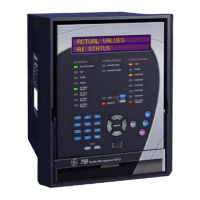2 - 2 750/760 FEEDER MANAGEMENT RELAY – COMMUNICATIONS GUIDE
CRC-16 ALGORITHM CHAPTER 2: MODBUS PROTOCOL
communication bus must have a unique address to prevent bus contention. All the
relay ports have the same address which is programmable from 1 to 254 (see the Port
Setup section in Chapter 5 of the instruction manual). Only the addressed slave will
respond to a packet that starts with its address. Note that the front port is an
exception to this rule; it will act on a message containing any slave address.
A master transmit packet with a slave address of 0 indicates a broadcast command.
All slaves on the communication link will take action based on the packet, but none
will respond to the master. Broadcast mode is only recognized when associated with
Function Codes 05h, 06h, and 10h. For any other function code, a packet with
broadcast mode slave address 0 will be ignored. See Clock Synchronization of Multiple
Relays on page 3-7 for an example of broadcast mode.
• Function Code: This is one of the supported functions codes of the 750/760 which tells
the slave what action to perform. See Supported Modbus Function Codes on page 3-1
for complete details. An exception response from the slave is indicated by setting the
high order bit of the function code in the response packet. See page 3–7 for further
details.
• Data: This will be a variable number of bytes depending on the function code. This
may include actual values, setpoints, or addresses sent by the master to the slave or
by the slave to the master.
• Cyclic Redundancy Check (CRC): This is a two byte error checking code. The RTU
version of Modbus includes a 16-bit cyclic redundancy check (CRC-16) with every
packet which is an industry standard method used for error detection. If a GE Multilin
Modbus slave device receives a packet in which an error is indicated by the CRC, the
slave device will not act upon or respond to the packet thus preventing any erroneous
operations. See the following section for a description of how to calculate the CRC.
• Dead Time: A packet is terminated when no data is received for a period of 3.5 byte
transmission times (about 15 ms at 2400 baud, 2 ms at 19200 baud). Consequently,
the transmitting device must not allow gaps between bytes longer than this interval.
Once the dead time has expired without a new byte transmission, all slaves start
listening for a new packet from the master except for the addressed slave.
CRC-16 Algorithm
The CRC-16 algorithm essentially treats the entire data stream (data bits only; start, stop
and parity ignored) as one continuous binary number. This number is first shifted left 16
bits and then divided by a characteristic polynomial (11000000000000101B). The 16 bit
remainder of the division is appended to the end of the packet, MSByte first. The resulting
packet including CRC, when divided by the same polynomial at the receiver will give a zero
remainder if no transmission errors have occurred. This algorithm requires the
characteristic polynomial to be reverse bit ordered. The most significant bit of the
characteristic polynomial is dropped, since it does not affect the value of the remainder.
Symbols: --> data transfer
A 16 bit working register
A
low
low order byte of A
A
high
high order byte of A

